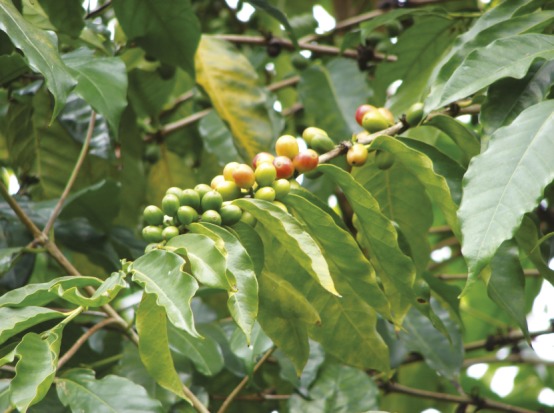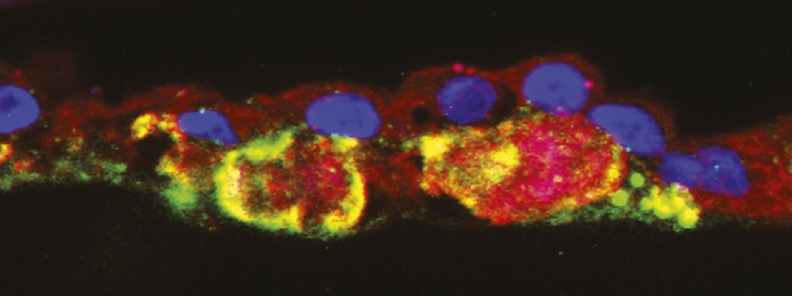How poison-dart frogs avoid self-intoxication
P. terribilis. Image courtesy of Wikipedia Commons/Micha L. Rieser.
The indigenous people of Central America devise blowpipe weapons by daubing darts with toxins derived from the skin glands of poison-dart frogs (Phyllobates terribilis). One such toxin, batrachotoxin (BTX), pries open sodium channels and alters their ion selectivity, disrupting electrical transmission through cell membranes. To determine how poison-dart frogs avoid intoxication despite harboring enough toxin to kill up to 20,000 mice, Sho-Ya Wang and Ging Kuo Wang (pp. 10491–10496) examined whether five previously reported, naturally occurring amino acid replacements in a subunit of the rat muscle sodium channel confer BTX resistance. As expected, replacing all five amino acids with natural variants conferred complete resistance in electrophysiological experiments. In contrast, mutant channels with single amino acid replacements remained sensitive to BTX—with the exception of the N1584T mutant, in which an asparagine residue at a specific location in the channel’s α-subunit was substituted with threonine. The N1584T variant, previously reported in P. terribilis muscle cells, could result from a single nucleotide change in the channel’s genetic script and confer BTX resistance on adult frogs, which can store more than 1 mg of the toxin in their skin. The counterpart asparagine residue in the α-subunit of the frog’s sodium channel likely represents a key structural element of the BTX receptor and helps explain how poison-dart frogs avoid self-intoxication, according to the authors. — P.N.
Climate, coffee, and pollinator distribution in Latin America

Coffea arabica. Image courtesy of Forest & Kim Starr (photographers).
Climate change is predicted to cause geographic range shifts for major crops, such as coffee, and associated pollinators, potentially endangering food security in some regions. Although current projections indicate large losses in areas suitable for coffee production, the coupled effects of climate change on pollinators and crops remain unclear. Pablo Imbach et al. (pp. 10438–10442) used ecological modeling to estimate future distribution changes in arabica coffee and 39 species of coffee-pollinating bees in Latin America, the world’s largest coffee-producing region. Under medium and high warming scenarios, the results suggest a 73–88% reduction in areas suitable for growing coffee by 2050. The models also suggest that bee diversity might decline by 8–18% in future areas suitable for growing coffee. However, 10 or more bee species are predicted to be present in 46–59% of the future areas suitable for growing coffee, according to the models. Furthermore, an increase in both coffee suitability and bee diversity, which mostly occurred in Central America, was projected for 10–22% of future areas suitable for coffee, whereas a decrease in both factors occurred in 34–51% of the areas. According to the authors, the findings highlight the need for strategies that account for the coupled effects of climate change on coffee-growing areas and bee pollination. — C.S.
Stem cell models of macular dystrophy

Drusen-like deposits underlying patient hiPSC-RPE in a dish.
Macular dystrophies, including age-related macular degeneration, are a group of eye disorders characterized by loss of central vision and the presence of drusen, which are lipid-rich deposits in the retina. Although a number of such disorders share key features and follow similar trajectories, their underlying mechanisms remain unknown, partly due to the lack of a suitable animal model. Chad Galloway et al. (pp. E8214–E8223) used human induced pluripotent stem cell-derived retinal pigment epithelium (hiPSC-RPE) to examine the specific role of RPE dysfunction in two features of macular dystrophy: accumulation of extracellular matrix protein and formation of drusen. Working with 11 different hiPSC-RPE lines, including cells derived from patients with three distinct macular dystrophies, the authors developed models and demonstrated that RPE dysfunction is sufficient to recapitulate the hallmark features of these conditions. Furthermore, the results reveal that similar molecular alterations are present in RPE cells derived from patients with distinct maculopathies, suggesting that the disorders manifest through shared mechanisms. The study demonstrates the utility of hiPSC-RPE as a model system and provides insights into the role of RPE cell dysfunction in this group of eye disorders, according to the authors. — T.J.
How the brain predicts sensory inputs
Perception is thought to involve the integration of sensory inputs and prior expectations, but the details of this process are unclear. Previous studies have been unable to resolve whether expectations induce templates of expected stimuli in the brain’s sensory cortex before the actual stimuli are presented. In a study involving 23 participants around 26 years of age, Peter Kok et al. (pp. 10473–10478) combined human magnetoencephalography with multivariate decoding techniques to resolve the timing of neural signals induced by expectations. Participants were first presented with auditory cues that predicted the likely orientation of the gratings that were shown next. When participants expected to be presented with a grating of a particular orientation based on the auditory cues, the researchers were able to identify a neural representation of the expected grating. This neural template was induced before the grating was presented, indicating that stimulus templates are preactivated in response to expectations. In addition, the stronger the prestimulus template of the expected grating orientation, the more participants benefited from the expectation when performing an orientation discrimination task. The prestimulus expectation signals did not induce a similar behavioral benefit on a different task where the grating orientation was not relevant to the task. The results suggest a mechanism by which the brain predicts future sensory stimuli to enhance perception, according to the authors. — S.R.



